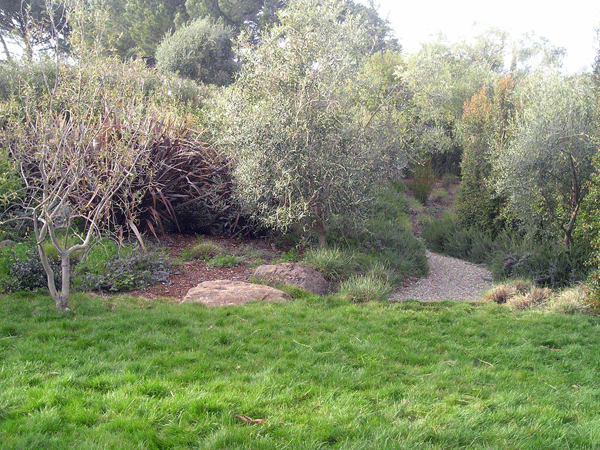I regularly receive notices of plant availabilities via email to notify me of what’s looking good in that wholesale nursery for the week. Besides being a good reminder of plants that have fallen through the cracks in my memory, many times I’m inspired to think of them in a new way. With spring around the corner – yes, hard to believe but true – this is the time to rethink your landscaping. From saving water to saving time, there are lots of ways to change what you have in your landscape to make it look more inviting and pleasing to the eye.
Tired of looking at all that moisture conserving but uninteresting mulch you spread last year? Whether you are replacing the lawn that you allowed to go brown last summer or just want an expanse of water-smart low grasses or grass-like plants for an area I’ve got some great suggestions for you.
If you want a lawn substitute that you can walk on but don’t need to use it as a play area, there are California native and prairie meadow grasses that will be perfect for this kind of situation. They need little irrigation and even less mowing. Some can be planted from seed, others from plugs or sod. Good choices include Idaho fescue, red fescue, carex pansa, Berkeley sedge, June grass and Hall’s bentgrass. Occasional shearing keeps them looking best but they may be left alone with no mowing at all. Weed control is important during establishment but a healthy stand may be sustained with virtually no weeding after that.
Other meadow grasses to walk on include buffalo grass and carex texensis. They stay short and can be either left alone or mowed every so often. They are tough enough for soccer games yet soft enough for bare feet. Scotts Valley Water District has a good list on their website of lawn substitute grasses and other water conserving plants.
Other areas in your landscape might look great with an expanse of a grass or grass-like plant with a slightly taller profile. Here are some of my favorite ornamental plants that are water smart, have beautiful foliage and often showy flower heads to sway in the breeze and bring life to the garden.
Moor grass or more specifically Sesleria ‘Greenlee’ is a newish introduction. This evergreen, clumping blue-green grass grows to one foot tall and a little wider with rose-purple flowers in spring and summer. It tolerates a wide range of conditions from wet to dry, sun to shade and is hardy down to zero degrees. It’s lovely planted in swaths to give your garden that restful feeling.
One of my very favorite small grass-like plants is Orange Libertia. Native to New Zealand, this stunning plant is great back lit and planted in masses. Growing to just under two feet tall, the leaves are green in the center and bright orange along the margins. Lightly fragrant, pure white blooms appear in the spring. This beauty takes the sun or light shade and has moderate water needs. It’s hardy to about 15 degrees and forms colonies by rhizomes.
Blue oat grass is another small grass that adds elegance to borders, containers and moonlit gardens. In late spring graceful stems bloom with delicate oat-like flowers that age to tawny brown by midsummer. Ruby grass, festuca ‘Siskiyou Blue’ and Chinese fountain grass are also small grasses that can be massed together for a stunning effect.
Plants with grass-like foliage like mondo grass, liriope, small phormiums and many of the dianella or flax lily are also water-smart and can be used alone or in groups.
It’s time to start thinking of new ways to save water and time this growing season.
Jan Nelson, a landscape designer and California certified nursery professional, will answer questions about gardening in the Santa Cruz Mountains. E-mail her at ja******@*ol.com, or visit www.jannelsonlandscapedesign.com to view past columns and pictures.













